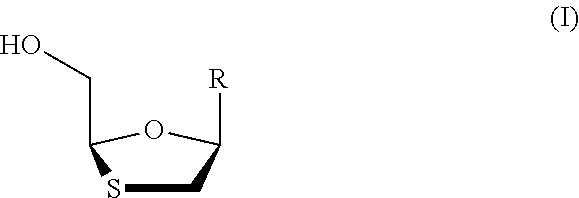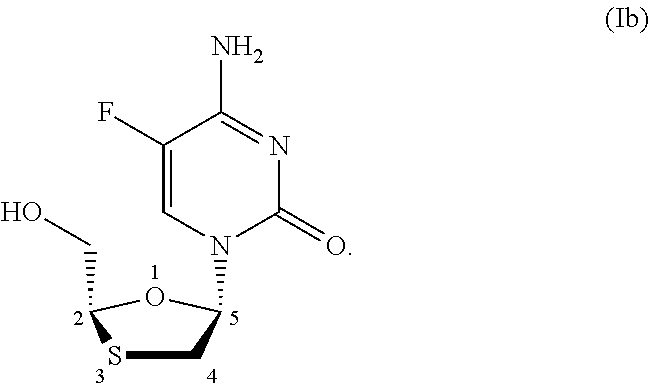Stereoselective process for preparation of 1,3-oxathiolane nucleosides
- Summary
- Abstract
- Description
- Claims
- Application Information
AI Technical Summary
Benefits of technology
Problems solved by technology
Method used
Image
Examples
example 1
Preparation of L-menthyl-5R-hydroxy-1,3-oxathiolanes-2R-carboxylate
[0051]
[0052]L-menthyl glyoxylate hydrate (prepared by reaction of L-menthol with glyoxalic acid as per process described in Synthetic Commun., 1990, 20, 2837-2847 by Fernadez F.) (100 gm, 0.434 mol, 1 molar equivalents), toluene (500 ml) and acetic acid (10 ml) were mixed under stirring and thus formed reaction mixture was heated up to 110-115° C., to remove water azeotropically. The reaction mixture was cooled up to 80° C. and solvent was distilled under vacuum up to the final volume becomes 300 ml. The reaction mixture was cooled to 50° C. and 1,4-Dithiane 2,5-Diol (33.1 gm, 0.217 mol, 2 molar equivalents) was added. The reaction mixture was refluxed (110-115° C.) and monitored the reaction by TLC. The mixture was cooled to 0-5° C. after completion of the reaction. 600 ml of 10% triethylamine in n-heptane was added to the reaction mixture drop wise over a period of an hour. The mixture was then maintained at 0-5° C...
example 2
Preparation of L-menthyl-5R-acetoxy-1,3-oxathiolane-2R-carboxylate
[0053]
[0054]L-menthyl-5R-hydroxy-1,3-oxathiolanes-2R-carboxylate (100 g, 0.346 mol, 1 molar equivalents), acetic anhydride (200 ml, 2.119 mol, 6.1 molar equivalents) and dichloromethane (500 ml) at 25-30° C. were mixed under nitrogen atmosphere. The reaction mixture was cooled to 0-5° C. and pyridine (50 ml) was added drop wise under stirring. The reaction mixture was stirred for 2-3 hours while maintaining the same temperature. The reaction was monitored with TLC and after completion it was quenched with water at 5-10° C. The mixture was stirred, settled and the layers were separated. The organic layer was washed with dilute HCl and concentrated under vacuum. n-Heptane (500 ml) was added to the residue and then heated to become a clear solution at about 60-65° C. The solution was cooled gradually up to room temperature and further to 0-5° C. The isolated solid product was filtered, washed with pre-cooled (0-5° C.) n-...
example 3
Preparation of L-menthyl-5S-(4-amino-2-oxopyrimidin-1-(2H)-yl)-1,3-oxathiolane-2R-carboxylate using various Lewis acids
[0055]
[0056]Cytosine (1.2 molar equivalents), N,O-bis-(trimethylsilyl)-acetamide (BSA) (2.7 molar equivalents) and acetonitrile (ACN) (5 volume) were mixed under nitrogen atmosphere at 25-30° C. to get clear solution. The solution was distilled out to remove excess BSA and acetonitrile completely under vacuum at 50-55° C. to get the residue of silylated cytosine into which fresh solvent was added (solution A). In a separate flask L-menthyl-5R-acetoxy-1,3-oxathiolane-2R-carboxylate (1.0 molar equivalents) and catalyst, as provided in table 1, in a solvent were stirred under nitrogen atmosphere (solution B). Solution A was mixed into solution B under stirring at 25-30° C. and continued the stirring at the same temperature for 12-18 hrs. The reaction was monitored by HPLC or thin layer chromatography. After completion of reaction, the reaction mixture was cooled to 10-...
PUM
 Login to View More
Login to View More Abstract
Description
Claims
Application Information
 Login to View More
Login to View More - R&D
- Intellectual Property
- Life Sciences
- Materials
- Tech Scout
- Unparalleled Data Quality
- Higher Quality Content
- 60% Fewer Hallucinations
Browse by: Latest US Patents, China's latest patents, Technical Efficacy Thesaurus, Application Domain, Technology Topic, Popular Technical Reports.
© 2025 PatSnap. All rights reserved.Legal|Privacy policy|Modern Slavery Act Transparency Statement|Sitemap|About US| Contact US: help@patsnap.com



